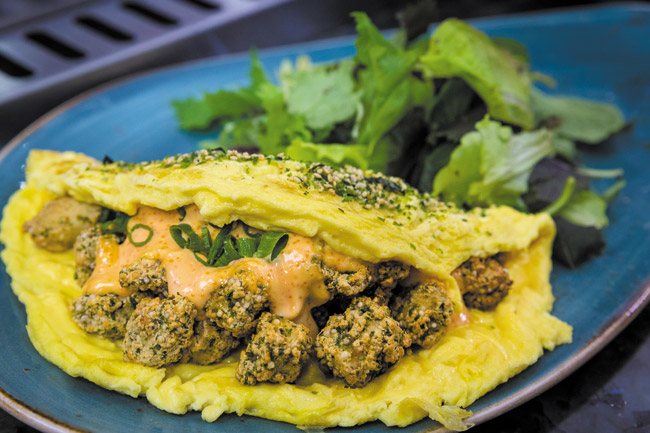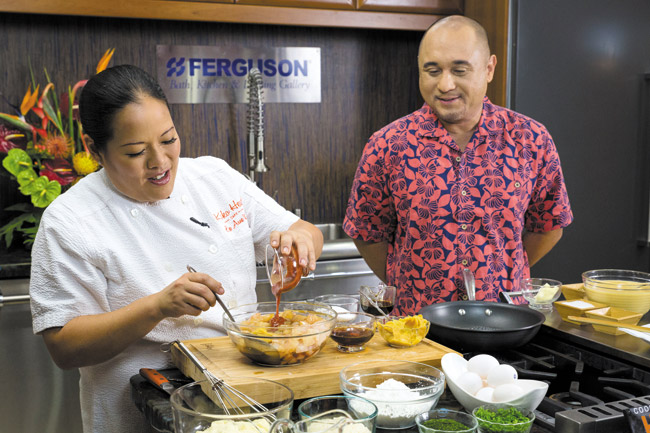Cooking Hawaiian Style Goes Worldwide
We are fast approaching our fourth season, and it’s like a dream come true for my executive co-producer Frank Abraham and me! Season 4 starts April 6 on OC-16, with all-new episodes and guests!
This week I thought I would share why we put this show together and the importance of local food from Hawaii not only here at home, but on the global stage. So many people have questions about what is Hawaiian food, or what is local food.
mw-lanai-0401115-chef-lee-anne-wong
In the mid-1800s, the Chinese came to work on the sugar plantations and introduced a wide variety of their native food to Hawaii, including noodles, rice, spices and seasonings. By the 1900s, Filipinos, Japanese, Koreans, Puerto Ricans and Portuguese were a big part of Hawaii and, like the Chinese, they also infused their culture and food into the mix.
During gatherings such as work-time lunches, although language often presented a barrier, food was the medium immigrants used to share a piece of each other’s culture. Little did they realize that they were creating what we now know as local food: fried noodles, Spam musubi and the world-famous plate lunch.
This mixture of flavors, along with the Hawaiian touch, created a whole new generation of recipes and collaborations of food. I remember my tutu (grandmother) telling me how lucky we were to have so many pieces of the world on our table and in our garden. She made everything from pinakbet (Filipino vegetables) to ahi poke.
Nowhere else in the world can you experience such a wide range of food on the dinner table.
So it’s through food that we choose to share our culture with the world. Cooking Hawaiian Style was created to preserve that generation of plantation days and share how we are constantly evolving in the foodie world.
If you look at our celebrity chefs like Alan Wong, Roy Yamaguchi and Sam Choy, they are pioneers who have introduced cooking Hawaiian style to the world.
We are very proud to announce that our show now will air nationwide, and internationally in Canada, Australia, New Zealand, the Philippines, Europe, UAE and Dubai on the Lifestyle Network, and so we get to share our aloha with the world through our food.
Watch Cooking Hawaiian Style on OC16 Monday at 7:30 p.m.
Here is a sneak-peek recipe from Chef Lee Anne Wong, a Food Network culinary super-star and owner of Koko Head Café in Kaimuki.
LEE ANNE WONG’S MAHI MAHI POKE OMELETTE
For Poke:
• 3 pounds mahi mahi filet, 3/4-inch dice
• 1/4 cup Aloha shoyu
• 1/4 cup mirin
• 1/4 cup saikyo (white miso) paste
• 3 tablespoons sugar
• 2 tablespoons sesame oil
• 1 tablespoon Sriracha paste
Mix all ingredients except mahi until well-blended. Toss to coat mahi pieces and allow 12-24 hours to marinate.
For Poke Dredge:
• 1 cup cornstarch
• 1/4 cup aonori or furikake (dried seaweed)
• 1/2 cup masago arare rice crackers
To cook mahi, heat fry oil to 375 degrees. Toss poke pieces in dredge until lightly coated. Fry mahi poke in small batches until just cooked, about 45 seconds to 1 minute in oil. Lightly salt after draining on paper towels. Use 3 ounces of cooked poke per portion.
For Omelette:
• 8 eggs
• 1/2 cup heavy whipping cream
• butter, for pan
• salt and pepper
Beat together eggs and heavy whipping cream. Butter an 8-inch frying pan and make a French-style flat omelette.
For Spicy Masago Aioli:
• 1 cup Kewpie mayonnaise
• 1/4 cup masago roe
• 1 1/2 tablespoons Sriracha paste
• 1 tablespoon rice vinegar
• 1/2 teaspoon sugar
• 1/2 tablespoon sesame oil
To serve: Make omelette, add cooked poke to middle of omelette, drizzle 1 ounce cold spicy aioli over poke, fold over omelette and sprinkle with furikake, as garnish.
To get thousands of free recipes, go to CookingHawaiianStyle.com







